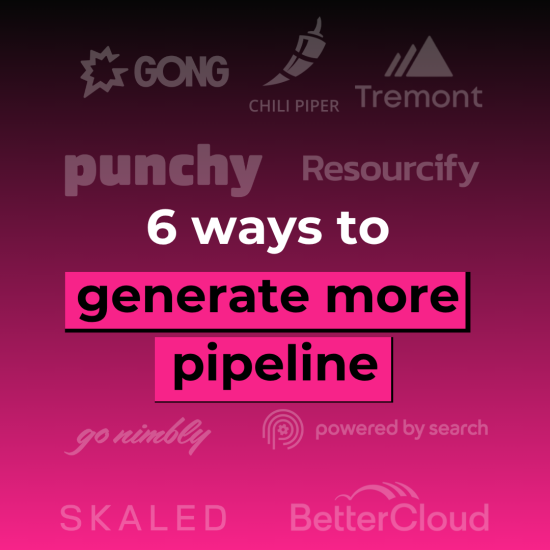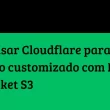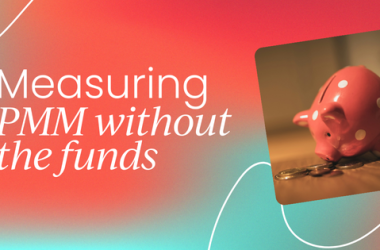This article was originally published in the SaaStock Blueprint newsletter. Subscribe to get content like this, straight to your inbox.
If there’s one major SaaS challenge on every founders’ lips right now, it’s pipeline generation.
Whether it’s changing buyer journeys, longer sales cycles or tighter budgets, generating SaaS pipeline is getting harder and the prevailing wisdom is to focus on quality over quantity.
From nailing your ideal customer profile (ICP) to effectively leveraging AI sales tools, here are six ways that SaaS leaders are generating pipeline successfully this year.
6 ways to overcome SaaS pipeline challenges in 2025
1. Improve sales & marketing efficiency
According to Gong Director of EMEA Enterprise Sales, Martin Garvey, 70% of sales reps’ time is spent on non-selling activity, such as filling in a CRM, writing-up meeting notes and sending sales emails. That’s a lot of potential improvement.
To make efficiency gains, review your sales and marketing workflows from the bottom up and pinpoint areas that can be automated, improved or simplified. For example, Dev Basu, CEO of Powered by Search, makes sure that all marketing actions, including content creation, don’t just increase traffic, but generate conversions. Meanwhile Jake Dunlap, CEO of Skaled, calls for differentiation in the buyer journey, so instead of giving generic demos, reps provide customised insights to each persona, thereby improving the effectiveness of each sales call.
2. Use AI to support your sales team
AI doesn’t do everything well (i.e. brand strategy, product messaging or deep connections with customers), but it does free up your team to focus where they add more value.
For example, Chili Piper employs AI agents to support SDRs with pipeline health, territory planning, lead qualification and CRM upkeep and Go Nimbly uses AI for:
-
- Lead scoring. Pocus to identify the best product-qualified leads (PQLs).
- Pre-meeting research. Clay to gather industry insights before a sales call (i.e. the top three trends for VP of operations in industrial manufacturing right now).
- Post meeting analysis. Gong to analyse sales calls and transcripts for useful insights (i.e. negative sentiment, frustration with data integrity).
There are so many AI tools out there, but don’t be put off. As Kyle Poyar advises: “if you’re not testing out these different tools, you’re really missing out. Play around with them and see how they can play a role in your go-to-market strategy.”
3. Really understand your ICP
When the going gets tough, get focused. In 2025, it’s not about getting volume, but enabling SDRs to precisely target your best-fit customers by outlining an ultra-specific ICP that pinpoints characteristics and responsibilities – not just job titles.
For David Politis, Founder and Executive Chairman of BetterCloud, narrowing down your ICP and buyer personas makes it much easier to sell. When BetterCloud did this, they cut their sales cycle by 30% and increased their close rate by 100%.
4. Align GTM teams
The traditional MQL model – where marketing creates awareness, generates pipeline and throws MQLs to the sales team to close – is dead. In 2025, marketing and sales must work together across the funnel.
For Emily He, Gong CMO, that means making sure that marketers understand their impact on revenue – not just pipeline – and therefore work closely with product, customer success and sales throughout the customer journey. As a SaaS leader, Emily recommends:
- Aligning on KPIs that hold all GTM teams accountable for the entire funnel and revenue impact.
- Using full funnel metrics (i.e. the impact on revenue and cost of customer acquisition) instead of metrics analysing pipeline at different stages (i.e. awareness metrics).
- Focusing marketing efforts on what generates the most revenue (not the most leads).
5. Focus on brand and positioning
To stand out in a crowded market, build a great brand. According to Angeley Mullins, CCO at Resourcify, building a strong brand enables consistent and scalable pipeline generation, so she recommends taking at least 20% to 30% of your overall budget and putting it on brand.
At the same time, differentiated positioning will help you succeed in your market by pinpointing:
- What problem your product solves.
- How you solve that problem better than competitors.
- Which companies and personas have that problem.
For Punchy Founder Emma Stratton, ‘positioning a product correctly is the key to success.’ By using messaging that:
- Uses casual conversational language,
- Echoes the voice of your customer,
- And focuses on the unique value of your solution for a specific audience, (instead of talking about your product’s features or tech capabilities)
you will showcase your value to your ICP, attract the right customers, and increase conversion.
6. Cut through the noise with in-person connections
The founders getting ahead in terms of pipeline generation are implementing the tactics above and adding another tool to their belt…in-person connections.
We’re seeing more companies make live events a core part of their demand generation efforts.
But it only works if you’re at the events that put you in the right room, with the right people.
At SaaStock Europe this year (14-15 October in Dublin), we’re introducing a new one-to-one meetings programme (Meetup), which will facilitate thousands of 15-minute, double opt-in meetings that are all about making moves, fast.
Find out more about Meetup at SaaStock Europe.





